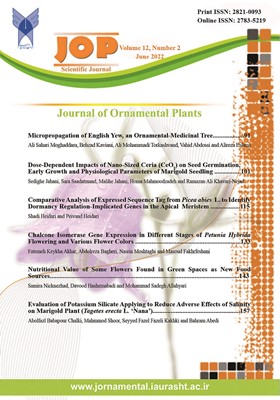-
-
فهرست مقالات
-
دسترسی آزاد مقاله
1 - Micropropagation of English Yew, an Ornamental-Medicinal Tree
Ali Sahari Moghadam Behzad Kaviani Ali Mohammadi Torkashvand Vahid Abdossi Alireza Eslami -
دسترسی آزاد مقاله
2 - Dose-Dependent Impacts of Nano-Sized Ceria (CeO2) on Seed Germination, Early Growth and Physiological Parameters of Marigold Seedling
Sedighe Jahani Sara Saadatmand Malihe Jahani Homa Mahmoodzadeh Ramazan Ali Khavari-Nejad -
دسترسی آزاد مقاله
3 - Comparative Analysis of Expressed Sequence Tags from <i>Picea abies</i> L. to Identify Dormancy Regulation-Implicated Genes in the Apical Meristem
Shadi Heidari Peivand Heidari -
دسترسی آزاد مقاله
4 - Chalcone Isomerase Gene Expression in Different Stages of <i>Petunia Hybrida</i> Flowering and Various Flower Colors
Fatemeh Keykha Akhar Abdolreza Bagheri Nasrin Moshtaghi Masoud Fakhrfeshani -
دسترسی آزاد مقاله
5 - Nutritional Value of Some Flowers Found in Green Spaces as New Food Sources
Samira Nicknezhad Davood Hashemabadi Mohammad Sadegh Allahyari -
دسترسی آزاد مقاله
6 - Evaluation of Potassium Silicate Applying to Reduce Adverse Effects of Salinity on Marigold Plant (<i>Tagetes erecta</i> L. ‘Nana’)
Abolfazl Babapour Chalki Mahmoud Shoor Seyyed Fazel Fazeli Kakhki Bhram Abedi
-
حقوق این وبسایت متعلق به سامانه مدیریت نشریات دانشگاه آزاد اسلامی است.
حق نشر © 1404-1400







